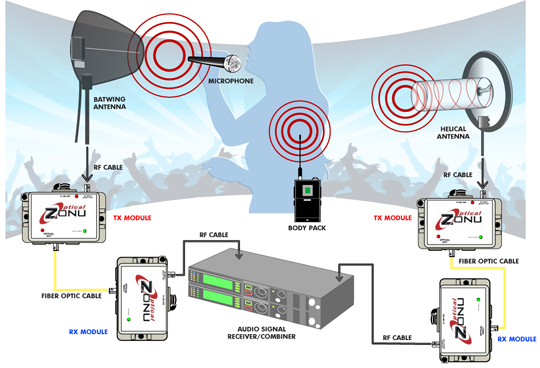One of many challenges Broadcast professionals encounter when covering events at large venues is increasing the range of their RF camera, wireless microphone and PL system equipment. Optical Zonu’s Fiber Optic or analog over fiber Link is designed to enhance the broadcaster’s coverage by transporting RF signals between RF audio and video antennas to their receivers transparently over long distances. This RFoF link can carry any RF signal within the range of 20 MHz to 3 GHz (optional extended bandwidth of 20 MHz to 6 GHz available) with virtually no loss, making it a better choice than traditional coaxial cable links. Fiber optic cable offers almost unlimited area coverage by greatly increasing the link distance over single mode or multi-mode fiber optic cable. This link is designed specifically with broadcast professionals in mind and supports most commonly used interfaces such as BNC (RF impedance) and ST (optical connection). Its supports both 50 ohm and 75 ohm termination. The link consists of low profile, standalone, semi-rugged Tx and Rx modules with power supplies.
This solution is deployed in mobile flexible installations for fiber video, voice and data connectivity. This is designed for Broadcast Centers and Studios as well at Cable TV head ends.
DVB-T & RF CAMERA SIGNAL APPLICATION

Typical field applications include digital microwave systems consisting of transmitters which are required to cover large areas, and multiple antennas with external BDCs (Block Down Converters). Down converted IF (Intermediate Frequency) signals can be transported via 50 Ω coaxial video cable butwith very limited range and a high degree of signal loss. Optical Zonu’s link extender will carry your IF signals over fiber optic cable for thousands of feetmore with virtually no signal loss. This link allows you to use a short piece of RG-6 BNC Coax cable between the BNC IF Output of the BDC (Block Down Converter) and the BNC Input of the Fiber Optic Tx (Transmitter). The Optical TX module takes in an RF signal and converts it to an optical signal, which is transported over a long fiber optic cable to reach the Optical Rx module, where the signal is converted back into its original RF form. Another short piece of RG-6 BNC Coax cable connects the BNC Output of the Fiber Optic Rx (Receiver) to the BNC Antenna Input on the Wireless Video Receiver. Overall, this is a very efficient method for the reliable delivery of your content.
WIRELESS MICROPHONE SIGNAL EXTENSION

Another common application is for wireless microphone signal distribution. You can extend the coverage of wireless microphones by remotely placing Batwing and Helical antennas farther away from your Audio Receiver with help of fiber optic cable. The Optical Tx module will be placed next to standard Batwing or Helical antennas, connected with a short piece of RG-6 BNC Coax Cable. The Optical TX module converts the input RF signal to an optical signal, which is transported over a long fiber optic cable run to reach the Optical Rx module, where the optical signal is converted back into its original RF form. The BNC Output of the Optical Rx module is connected to the Audio Receiver with another piece of short RG-6 cable. In this way, antennas are not required to stay within close proximity of Audio Receiver. They may be placed much farther away, thus extending coverage of your wireless microphones.

